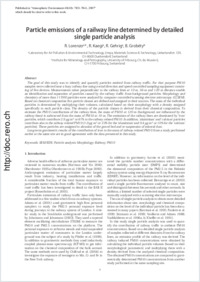Particle emissions of a railway line determined by detailed single particle analysis
- Lorenzo, Ronny Laboratory for Air Pollution + Environmental Technology, Empa, Duebendorf, Switzerland - Institute for Mineralogy and Petrography, University of Fribourg, Switzerland
- Kaegi, R. Laboratory for Air Pollution + Environmental Technology, Empa, Duebendorf, Switzerland
- Gehrig, R. Laboratory for Air Pollution + Environmental Technology, Empa, Duebendorf, Switzerland
- Grobéty, Bernard Institute for Mineralogy and Petrography, University of Fribourg, Switzerland
-
11.10.2006
Published in:
- Atmospheric Environment. - 2006, vol. 40, no. 40, p. 7831-7841
English
The goal of this study was to identify and quantify particles emitted from railway traffic. For that purpose PM10 samples were collected near a busy railway line using a wind direction and speed controlled sampling equipment consisting of five devices. Measurements taken perpendicular to the railway lines at 10, 36 and 120 m distance enable an identification and separation of particles caused by the railway traffic from background particles. Morphology and chemistry of more than 11,000 particles were analysed by computer controlled scanning electron microscopy (CCSEM). Based on chemical composition five particle classes are defined and assigned to their sources. The mass of the individual particles is determined by multiplying their volumes, calculated based on their morphology with a density assigned specifically to each particle class. The density of the particle classes is derived from their chemical composition. To estimate the PM10 contributions of the railway lines, the mass of PM10 at 120 m (background, not influenced by the railway lines) is subtracted from the mass of PM10 at 10 m. The emissions of the railway lines are dominated by ‘iron’ particles, which contribute 2.9 μg m⁻³ or 67% to the railway related PM10. In addition, ‘aluminium’ and ‘calcium’ particles contribute also to the railway related PM10 (1.0 μg m⁻³ or 23% for the ‘aluminium’ and 0.4 μg m⁻³ or 10% for the ‘calcium’ particles). These particles are assigned to abrasion of the gravel bed and re-suspension of mineral dust.Long-term gravimetric results of the contribution of iron to the mass of railway related PM10 from a study performed earlier at the same site are in good agreement with the data presented in this study.
- Faculty
- Faculté des sciences et de médecine
- Department
- Département de Géosciences
- Language
-
- English
- Classification
- Meteorology, climatology
- License
- License undefined
- Identifiers
-
- RERO DOC 8135
- DOI 10.1016/j.atmosenv.2006.07.026
- Persistent URL
- https://folia.unifr.ch/unifr/documents/300187
Statistics
Document views: 161
File downloads:
- grobety_per.pdf: 227
